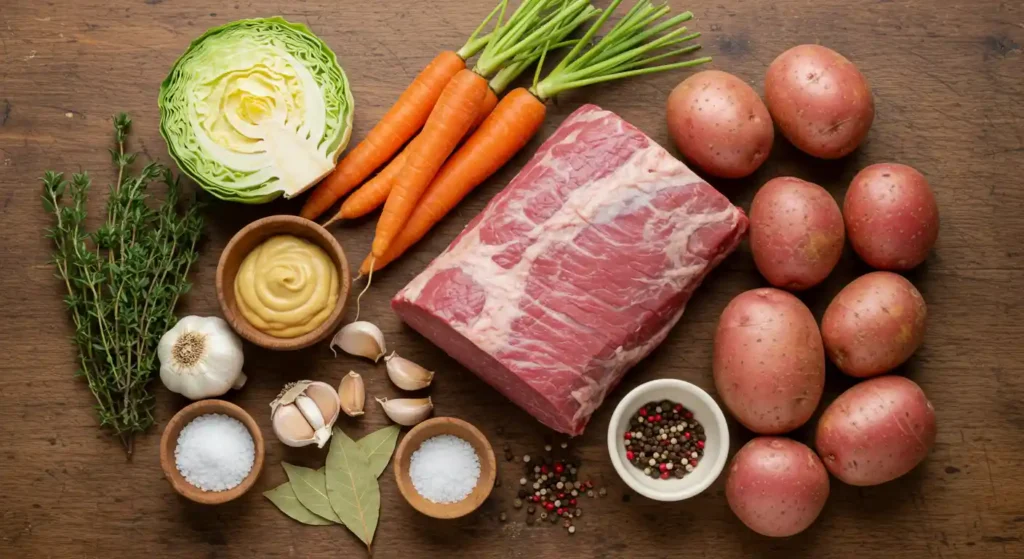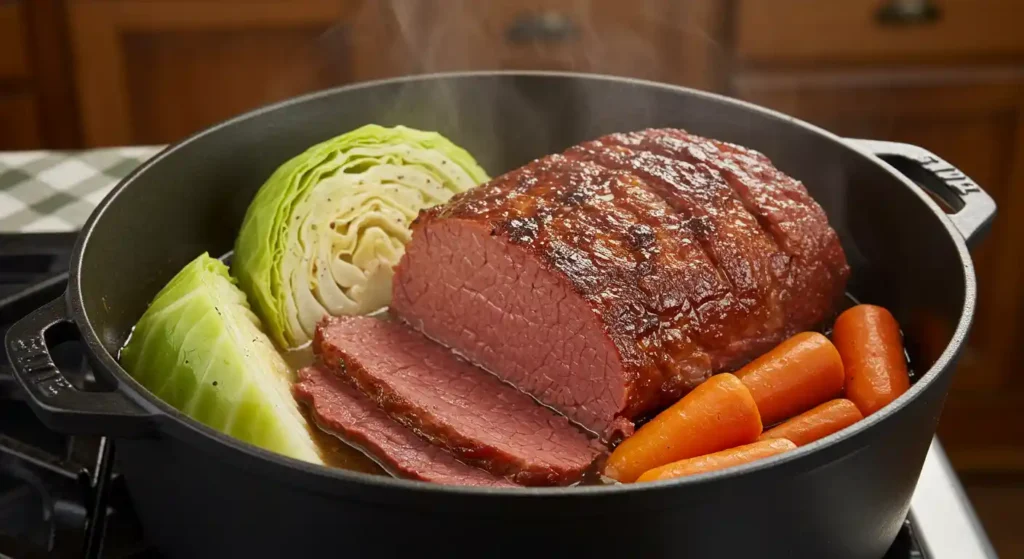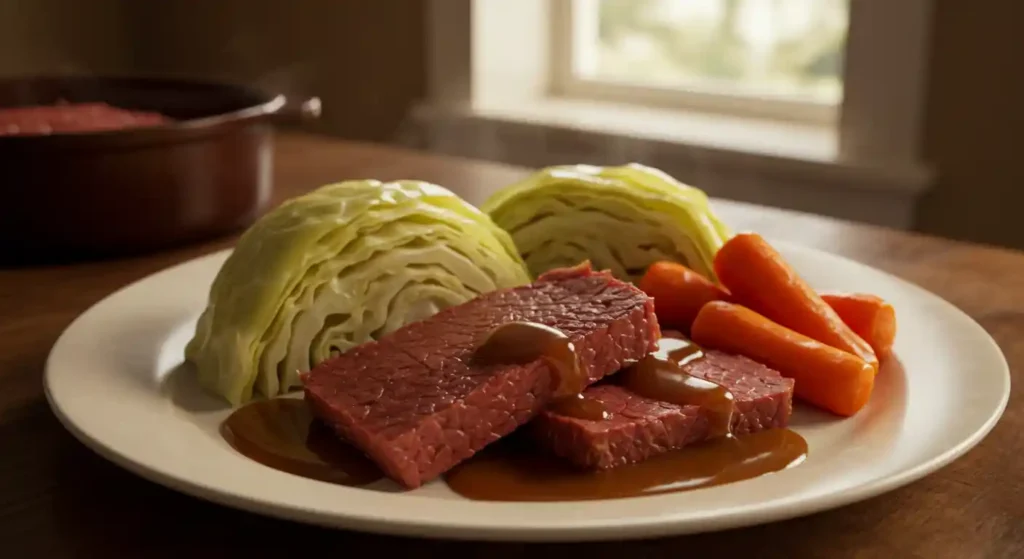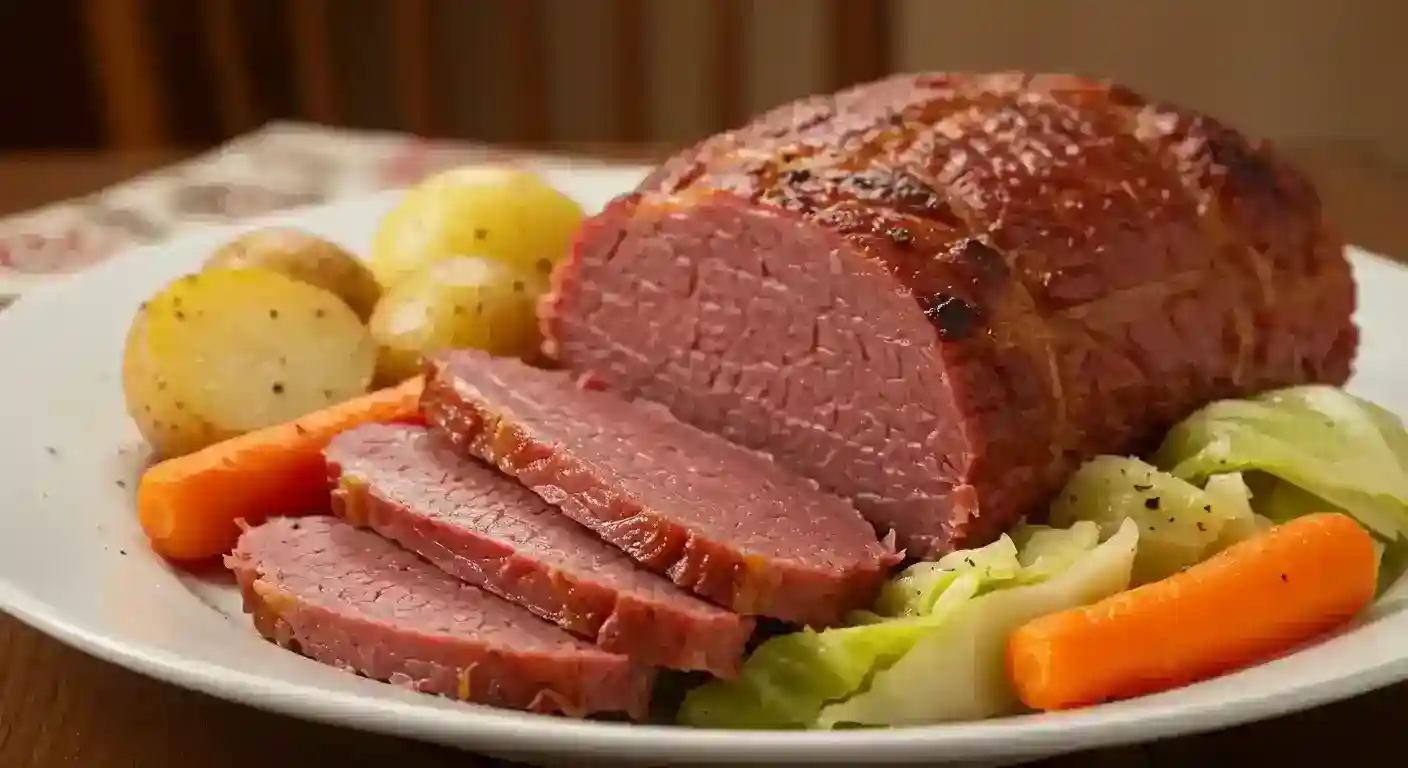Corned beef and cabbage is a comforting, nostalgic dish often linked to St. Patrick’s Day. This hearty pairing of tender corned beef and vibrant cabbage is a staple of Irish-American cuisine, bringing families together to celebrate Irish heritage. Whether enjoyed on a cozy afternoon or during festivities, it always adds warmth and joy to the table
Growing up, corned beef and cabbage was a staple in our household, especially during St. Patrick’s Day. My grandmother’s recipe was one of those dishes that could fill the house with an irresistible aroma, making it impossible to resist. We’d all sit around the table, laughing and savoring the rich flavors. The heartiness of the corned beef, combined with the mild crunch of cabbage, always felt like a hug in a bowl—filling, satisfying, and full of love.
Beyond its delicious flavor, corned beef and cabbage is also surprisingly nutritious. The cabbage is packed with fiber, vitamins C and K, and antioxidants, while the corned beef provides a good source of protein. Together, they create a well-balanced, nourishing meal that’s perfect for both special occasions and everyday comfort.
Table of Contents
Ingredients for Corned Beef and Cabbage: A Perfect Balance of Flavor

To create the perfect corned beef and cabbage, you’ll need a few simple yet flavorful ingredients that come together to create this beloved dish. Here’s a detailed list of what you’ll need:
- Corned Beef Brisket: The star of the dish, corned beef brisket is a cut of beef that’s been cured in a brine with a mix of spices. For the best flavor, look for a high-quality corned beef brisket, ideally one with a good balance of fat and meat to ensure tenderness and richness.
- Cabbage: Fresh cabbage provides a crunchy, mildly sweet contrast to the salty, savory corned beef. It softens beautifully as it cooks, absorbing the flavors of the broth and spices.
- Carrots: Carrots add a subtle sweetness and vibrant color to the dish. When cooked, they complement the richness of the corned beef and provide a perfect balance of textures.
- Potatoes: Potatoes are a classic addition, making this meal hearty and filling. Choose waxy potatoes, such as red potatoes or Yukon Golds, as they hold their shape well during cooking.
- Onion: A large onion adds aromatic depth and sweetness to the broth, enhancing the overall flavor profile.
- Garlic: Garlic brings an aromatic, savory note to the dish that pairs wonderfully with the spices and broth.
- Spices: The key spices for corned beef and cabbage include bay leaves, whole peppercorns, and mustard seeds. These spices infuse the broth, creating a savory, aromatic base for the meat and vegetables.
- Broth: Beef broth or water is used to cook the corned beef and vegetables, adding moisture and flavor. Beef broth will add a richer taste, while water can be used for a lighter version.
Substitutes for Dietary Preferences
If you’re looking for healthier or dietary-specific alternatives, here are a few options:
- Healthier alternative: Opt for leaner cuts of corned beef, or substitute with turkey breast for a lighter version without sacrificing flavor.
- Gluten-free: If you’re sensitive to gluten, ensure that your broth and spices are labeled gluten-free to avoid any hidden gluten in processed ingredients.
- Vegetarian version: For a plant-based twist, substitute the corned beef with seitan or jackfruit. These meat alternatives absorb the spices and flavors wonderfully, making them great substitutes for the traditional dish.
Tips on Ingredient Selection for baked Corned Beef and Cabbage
- Corned Beef: Always choose a high-quality corned beef brisket for the best results. Look for a brisket with a nice marbling of fat for added flavor and tenderness.
- Fresh Vegetables: When selecting vegetables like cabbage, carrots, and potatoes, go for the freshest options you can find. Fresh produce not only enhances the flavor but also provides a more vibrant texture that makes the dish feel even more satisfying.
How to Make Corned Beef and Cabbage: Step-by-Step Instructions

This classic corned beef and cabbage recipe is easy to follow, ensuring a flavorful and hearty meal that the whole family will love. Whether you’re preparing it for St. Patrick’s Day or simply enjoying a comforting dish, here’s a detailed guide to make this beloved meal from start to finish.
1. Prepare the Corned Beef
You can start by rinsing the corned beef with cold water. This step is essential to remove any excess salt from the brining process, ensuring the dish doesn’t turn out too salty. Once rinsed, place the corned beef brisket into a large pot or Dutch oven. The pot should be large enough to comfortably hold the brisket along with all the vegetables and liquid.
2. Cook the Corned Beef
Pour the beef broth (or water) into the pot, making sure the corned beef is completely submerged. If the broth doesn’t fully cover the meat, add extra water.. Toss in the garlic, onion, and spices—this includes the bay leaves, whole peppercorns, and mustard seeds. These spices will infuse the broth and corned beef with deep, aromatic flavors. Heat the pot over medium-high heat until it comes to a boil. Once it begins boiling, lower the heat to low and cover the pot
Allow the corned beef to simmer gently for 3-4 hours, or until it becomes tender and can be easily shredded with a fork. The slow simmering process allows the flavors to meld together and makes the corned beef incredibly tender.
3. Prepare the Vegetables
As the corned beef cooks, prepare the vegetables. Peel and chop the potatoes, carrots, and onion into manageable pieces. For the cabbage, cut it into quarters and remove the tough core. Then slice it into wide strips or wedges. Having your vegetables ready will help speed up the process once the corned beef is tender.
4. Cook the Vegetables
Once the corned beef has simmered for several hours and is fork-tender, it’s time to add the vegetables. Start with the potatoes and carrots, as they take a little longer to cook. Add them to the pot and let them cook for about 15-20 minutes, or until they are nearly done. You want them to be tender but not overly soft, as they will continue cooking with the cabbage.
5. Add the Cabbage
After the potatoes and carrots are almost tender, add the cabbage to the pot. Stir it in gently and let it cook for an additional 10-15 minutes. The cabbage should be tender but still vibrant in color, with a slight crunch to it. The cabbage will soak up all the wonderful flavors from the broth, making it the perfect complement to the corned beef.
6. Serve
Once everything is fully cooked, take the corned beef out of the pot. Slice the corned beef against the grain into thin, juicy slices. Arrange the sliced corned beef on a platter and serve with the vegetables. For an added touch, spoon some of the flavorful broth over the meat and vegetables.
Cooking Tips for Extra Flavor
- Flavor Enhancement: If you want to deepen the flavors, consider cooking the corned beef the night before. Let it rest in the fridge overnight to allow the flavors to meld together. The next day, simply reheat the corned beef and vegetables, and enjoy even more flavorful results.
- Slow Cooker Option: For a more hands-off approach, use a slow cooker. Simply place the rinsed corned beef and the remaining ingredients into the slow cooker, cover with broth, and cook on low for 6-8 hours. This method is great if you want a stress-free cooking experience, and it ensures your corned beef will be tender and delicious.
By following these easy steps, you’ll create a mouthwatering dish that’s sure to become a family favorite. Whether you’re cooking it on the stovetop or in a slow cooker, corned beef and cabbage is a satisfying meal that delivers both flavor and tradition.
Tips & Variations for Your Corned Beef and Cabbage recipe
Corned beef and cabbage is a versatile dish that can be easily adjusted to suit different dietary preferences or to add new flavors. Here are a few tips and variations to make the dish your own:
Dietary Adjustments
- Low-Carb Option: If you’re following a low-carb diet, simply skip the potatoes and replace them with cauliflower. Cauliflower, when cooked until tender, can mimic the texture of potatoes and absorb the delicious flavors of the broth, making it an excellent, carb-free substitute.
- Spicy Twist: For those who enjoy a little heat, horseradish is a fantastic addition. Add a spoonful of horseradish to the broth while it simmers to introduce a spicy kick that complements the richness of the corned beef and balances the cabbage’s sweetness.
Flavor Enhancements
- Fresh Herbs: To elevate the dish with a burst of freshness, consider adding a handful of fresh herbs like thyme or parsley toward the end of cooking. These herbs will add a light, aromatic flavor that brightens the dish and enhances its overall complexity.
- Mustard Seed Variations: While the standard mustard seeds add a warm, subtle spiciness, you can experiment with different types of mustard seeds, such as yellow mustard seeds or brown mustard seeds. Brown mustard seeds will add a more pungent flavor, while yellow mustard seeds offer a milder, slightly sweeter taste.
Serving Ideas
- Mustard: A simple but classic accompaniment for corned beef and cabbage is mustard. Its tangy, sharp flavor complements the richness of the meat and the sweetness of the cabbage, making each bite more flavorful.
- Irish Soda Bread: For an authentic Irish touch, serve the corned beef and cabbage with a side of Irish soda bread. Its slightly dense, hearty texture pairs perfectly with the flavors of the dish and adds a comforting, traditional element to the meal.
These variations and enhancements offer endless possibilities for creating a dish that’s tailored to your taste and dietary needs. Whether you prefer a spicy kick, a low-carb version, or a burst of fresh herbs, corned beef and cabbage can easily be customized to become your new favorite meal.
Nutritional Information for instant pot Corned Beef and Cabbage

Corned beef and cabbage is a hearty, satisfying dish that not only delivers on flavor but also offers a solid nutritional profile. Here’s an estimate of the nutritional breakdown per serving, based on a balanced portion of corned beef, cabbage, potatoes, and carrots.
Calorie Breakdown
- Calories per serving: Approximately 350-400 calories per serving (about 1/4 of the dish). The total calorie count can vary depending on the size of the portions, the cut of corned beef used, and whether any additional ingredients or sauces are added.
Macronutrient Details
- Protein: Corned beef is a great source of protein, providing about 20-25 grams of protein per serving. The leaner cuts of corned beef contribute a solid protein punch, supporting muscle growth and repair.
- Fiber: The cabbage and carrots in this dish offer a significant amount of dietary fiber. A serving of corned beef and cabbage provides about 5-7 grams of fiber—most of it coming from the cabbage and carrots. Fiber helps with digestion, promotes satiety, and supports overall gut health.
- Carbohydrates: The potatoes contribute a moderate amount of carbohydrates to the dish—approximately 25-30 grams per serving. While potatoes provide energy, they also add a comforting, starchy element to the meal. Opting for fewer potatoes or substituting them with cauliflower can reduce the carb content for those on a low-carb diet.
Health Benefits of corned beef recipe
- Protein without excess fat: Using lean cuts of corned beef helps reduce the overall fat content while still providing a good amount of protein. This makes the dish filling and nourishing without excessive calories from fat.
- Vitamins and minerals: This dish is a great source of essential vitamins and minerals, thanks to the vegetables. Cabbage, in particular, is rich in vitamin C, which helps boost the immune system and promote skin health. Additionally, the potatoes provide a source of potassium, which is important for heart health, and the carrots contribute vitamin A, supporting vision and immune function.
In summary, corned beef and cabbage is a nutrient-dense meal that balances protein, fiber, and carbs. It provides essential vitamins and minerals, making it not only a delicious but also a health-conscious choice for a hearty, fulfilling meal.
Common Mistakes & Fixes for Corned Beef and Cabbage
Making corned beef and cabbage seems straightforward, but like any classic dish, there are a few common pitfalls that can affect the final result. Here are some mistakes to watch out for, along with solutions to ensure your dish turns out perfectly every time.
Common Mistakes
- Overcooking the Corned Beef: One of the most common mistakes is overcooking the corned beef. While you want it to be tender, if cooked for too long, it can become dry and tough, losing its melt-in-your-mouth texture.
- Not Trimming the Corned Beef Properly: Corned beef often comes with a thick layer of fat. While some fat is necessary for flavor, if left untrimmed, it can result in a greasy, overly fatty dish.
- Overcooking the Cabbage: Cabbage can turn mushy and lose its vibrant color if left in the pot for too long. While it needs to cook through, it’s important to avoid overcooking, as it can become unappetizing and lack texture.
Solutions
- Simmer the Corned Beef Slowly: To avoid overcooking, simmer the corned beef slowly over low heat for several hours. This will allow the meat to become tender and juicy without turning tough. If you’re using a slow cooker, the low and slow method works perfectly for the most tender corned beef.
- Trim Excess Fat Before Cooking: Before placing the corned beef in the pot, trim off any excess fat. While a little fat enhances flavor, too much will make the dish greasy. Aim to leave a thin layer of fat to ensure tenderness, but remove any large chunks that could make the dish overly fatty.
- Watch the Cabbage Carefully: To keep the cabbage from becoming mushy, add it toward the end of the cooking process—about 10-15 minutes before serving. This way, it will still be tender but retain its color and texture. If you accidentally leave it in too long, simply remove it earlier next time to prevent overcooking.
By avoiding these common mistakes and following these simple fixes, you’ll be able to prepare a corned beef and cabbage dish that is flavorful, tender, and perfectly balanced.
Frequently Asked Questions (FAQs) for Corned Beef and Cabbage
Can I make this ahead of time?
Yes, corned beef and cabbage can easily be prepared a day in advance. In fact, preparing it ahead of time lets the flavors blend together even more. After cooking, let the dish cool, and then store it in an airtight container in the refrigerator. When ready to serve, simply reheat the corned beef and vegetables on the stove or in the microwave. This method also makes it a great option for meal prep or large gatherings.
How should I store leftovers?
To store leftovers, place the corned beef and vegetables in an airtight container and refrigerate them. The dish will stay fresh for up to 3 days. For best results, make sure to cool the food down to room temperature before refrigerating it to avoid any condensation that could affect the flavor and texture.
Can I freeze this dish?
Yes, you can freeze corned beef and cabbage! To do so, it’s best to freeze the corned beef and vegetables separately. Portion the corned beef and vegetables into freezer-safe containers or bags. Corned beef can be frozen for up to 3 months, while the vegetables will stay good for about 2-3 months. When you’re ready to eat, thaw in the refrigerator overnight and reheat on the stove or in the microwave.
What should I serve it with?
Corned beef and cabbage is delicious on its own, but it pairs wonderfully with a variety of traditional sides. Some popular options include:
- Mashed potatoes: Creamy mashed potatoes complement the rich flavors of the corned beef.
- Irish soda bread: A slightly dense, hearty bread that’s perfect for soaking up the flavorful broth.
- Steamed green beans: A light, crisp side that adds a fresh contrast to the richness of the main dish.
These sides add variety and texture, making your meal even more satisfying and complete.
Conclusion & Call to Action
Corned beef and cabbage is a timeless, comforting dish that brings together rich flavors and wholesome ingredients, making it perfect for special occasions like St. Patrick’s Day or any time you crave a hearty, satisfying meal. With its tender corned beef, flavorful broth, and vibrant vegetables, this recipe will surely become a family favorite.
Now, it’s your turn to try this dish and create lasting memories around the table. Whether you’re making it for a holiday or just for a cozy night in, this recipe offers a delightful taste of tradition. I’d love to hear how it turns out! Feel free to share your experiences in the comments, along with any tweaks you’ve made to the recipe or pictures of your delicious creation.
If you’re looking for more hearty meal ideas or Irish-inspired dishes, be sure to check out the other recipes on the blog. From savory stews to flavorful breads, there’s no shortage of comforting meals to explore. Enjoy cooking, and don’t forget to savor every bite of your Delightful Crab Cake Eggs Benedict


2 thoughts on “How to Make easy Corned Beef and Cabbage A Hearty Tradition”
Comments are closed.